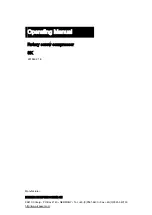
GB | 19
16
Noise
–
Wear ear muffs when you use the compres
sor.
17
Replacing the power cable
–
To prevent hazards, leave the replacement of
damaged power cables strictly to the manu
facturer or a qualified electrician.
–
There is a risk of electric shock!
18
Inflating tires
–
Directly after inflating tires, check the pres
sure with a suitable pressure gauge, for
example at your filling station.
19
Roadworthy compressors for building site opera
tions
–
Make sure that all lines and fittings are suit
able for the maximum permissible operating
pressure of the compressor.
20
Place of installation
–
Set up the compressor on an even surface
22.
Supply hoses at pressures above 7 bar should be
equipped with a safety cable (e.g. a wire rope).
23.
Avoid overstressing the piping system by using
flexible hose connections to prevent kinking.
24.
Use a residual current circuit breaker with a trig
ger current of 30 mA or less. Using a residual cur
rent circuit breaker reduces the risk of an electric
shock.
Warning! This electric tool generates an electro
magnetic field during operation. This field can impair
active or passive medical implants under certain con
ditions. In order to prevent the risk of serious or dead
ly injuries, we recommend that persons with medical
implants consult with their physician and the manu
facturer of the medical implant prior to operating the
electric tool.
ADDITIONAL SAFETY INSTRUCTIONS
Observe the corresponding operating manuals
of the respective compressed air tools / com-
pressed air attachments!
The following general
warnings must also be observed.
Safety instructions for working with com-
pressed air and blasting guns
•
Ensure there is sufficient distance to the product,
at least 2.50 m, and keep the compressed air tools
/ compressed air attachments away from the com
pressor during operation.
• The compressor pump and lines can become very
hot during operation. Touching these parts will
burn you.
• The air which is sucked in by the compressor
must be kept free of impurities that could cause
fires or explosions in the compressor pump.
• When releasing the hose coupling, hold the hose
coupling piece with your hand. This way, you can
protect yourself against injury from the rebound
ing hose.
• Wear safety goggles when working with the
blow-out pistol. Foreign bodies or blown off parts
can easily cause injuries.
• Wear safety goggles and a respirator when work
ing with the compressed air pistol. Dusts are harm
ful to health! Injuries can be easily caused by for
eign objects and blown away parts.
• Do not blow at people with the blowout pistol
and do not clean clothes while being worn. Risk
of injury!
Safety instructions when using spraying
attachments (e.g. paint sprayers*)
• Keep the spray attachment away from the
compressor when filling so that no liquid comes into
contact with the compressor.
• Never spray in the direction of the compressor
when using the spraying attachments (e.g. paint
sprayers). Moisture can lead to electrical hazards!
•
Do not process any paints or solvents with a fl ash
point below 55 °C. Risk of explosion!
• Do not heat up paints or solvents. Risk of explosion!
• If hazardous liquids are processed, wear protective
filter units (face guards). Also, adhere to the safety
information provided by the manufacturers of such
liquids.
• The details and designations of the Ordinance on
Hazardous Substances, which are displayed on the
outer packaging of the processed material, must be
observed. Additional protective measures are to be
undertaken if necessary, particularly the wearing of
suitable clothing and masks.
• Do not smoke during the spraying process and/or
in the work area. Risk of explosion! Paint vapours
are easily combustible.
• Never set up or operate the equipment in the vicinity
of a fire place, open lights or sparking machines.
• Do not store or eat food and drink in the work area.
Paint vapours are harmful to your health.
•
The work area must exceed 30 m³ and suffi cient
ventilation must be ensured during spraying and
drying.
• Do not spray against the wind. Always adhere to
the regulations of the local police authority when
spraying combustible or hazardous materials.
• Do not process media such as white spirit, butyl
alcohol and methylene chloride with the PVC
pressure hose. These media will destroy the
pressure hose.
• The work area must be separated from the
compressor so that it cannot come into direct
contact with the working medium.
* Optional item
Summary of Contents for 3906139953
Page 2: ...2 3 3 1 1 1 3 4 1 2 5 8 9 10 2 2 6 5 7 10 11 11 1 11 2 11 3...
Page 3: ...3 4 4 4 4 1 1 4 4 2 2 A...
Page 4: ...4 4 5 5 5 1 5 1 E D 5 2 5 2 6 6 6 1 6 1 B C F 4...
Page 66: ...66...
Page 67: ...67...
















































